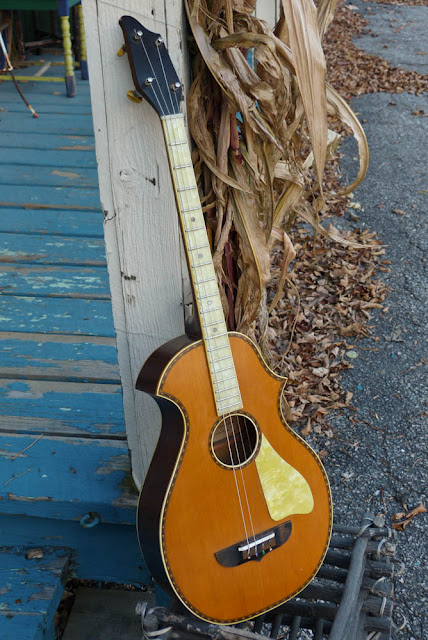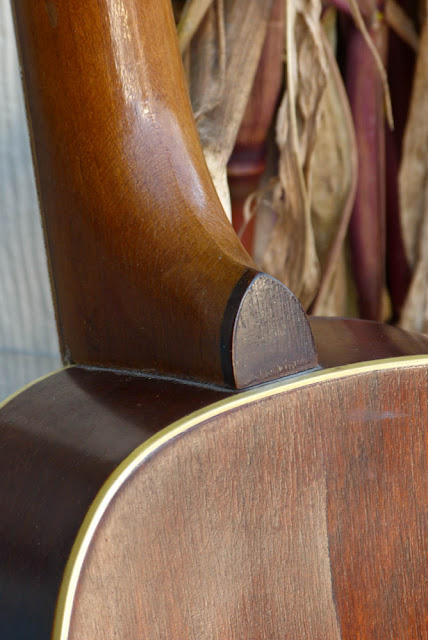1920s Stromberg-Voisinet Tenor Guitar
Update 2015: While I worked on this years ago, this tenor was recently purchased by from its former owner (my customer) and sent to me for work before going on. I've therefore updated the whole post's information. The recent work included a neck reset, refret, new bone saddle (had to cut a new slot, too), new bone nut, some seam and crack repair/cleating (some was old work), and of course a good setup. It also got a new set of geared vintage (period) banjo-style pegs which replaced some morose friction units.
This instrument has a strange "Musketeers - for the professional" branding in the soundhole but it was clearly made by Kay/Stromberg-Voisinet in the late 20s or early 30s and in Chicago. It's got a long 23" scale but a smaller "size 5" body that's in the Kay Kraft/2 point styling familiar to the Kay brand of the 30s. Like other Kay/SV products of the time, the build is sturdy, a little stiff, and practical. It's also a little curious and that accounts for the cool factor.
The new owner of this instrument wanted to use it in octave mandolin tuning and so that's how it's setup -- however, with an unwound A string as I believe the heavier-duty octave mandolin gauges many people prefer (with wound A) are just brutal on an old tenor like this. They just weren't designed for the tension. She plays (now) spot-on and has a good, mandolin-y sort of tone. It's not big and bloomy like you'd expect from an 0-size or larger x-braced tenor (read: 0-18T) but more focused and clean with a lot of sustain.
I know -- the look is great! The pearloid is a classic Kay/SV style and the "marquetry" purfling is, of course, very hip.
The "winged" bridge is top-loading and I added extra ball-ends to keep the overwound portion of the current strings off the saddles. Different brands have different overwound portions but most modern strings have overwound endings that are twice or more as long as vintage strings (so, when this was built, this wouldn't have been an issue).
My new bone saddle is compensated and required a new, wider slot to install (this originally had a fret saddle which was non-compensated).
New bone nut, new (vintage) tuners. You can see the marks and wear where the old friction peg ferrules used to be, however.
Strings are 45w G, 28w D, 19 A, 11 E. I used nickel windings to give a bit more of a mellow, fundamental sound.
The board is bound in cream (now yellowed) binding and has a pearly-white pearloid overlay. There's "black" pearloid dots inlaid into it, though, which looks terribly cool.
I had to refret this guitar to bring it to its full potential: the pearloid boards tend to dry up into a convex shape and all the frets start wiggling out. In addition the neck had a small warp to it so the practical solution was to install tall/narrow frets (glued-in as well because of the convex board shape) and then level and dress them down to a height that imparted a "straight neck" via taking material off the fret tops.
This is a very handy way of addressing this as the other option -- taking all the pearloid off, leveling the board, and reinstalling all the pearloid and binding to match -- is a serious drain on time and the customer's pocket!
Since first repairing this (2012), the end-seam had sprung and so I had to re-repair a length of the longer back crack (on the bottom) as well as the seam. It got a cleat this time around as well (though both the lower back crack and top back crack can't truly be "seen" inside, they're so tight internally).
Geared vintage Grover banjo pegs are a joy compared to the funky old friction pegs. I grabbed these on eBay for the new owner and they look grand on it compared to a new repro-style unit.
















Comments